Cleaner Air
“You know, a lot of times I talk about the fact that we can grow our economy and protect our environment. We've shown over the last decades that that is possible. Our economy has grown 164 percent in three decades. According to the EPA report released yesterday, air pollution from six major pollutants is down by 48 percent during that time. It's possible to grow the economy and protect the air. We're proving it here in America.”
President George W. Bush
Remarks on Clear Skies Legislation
East Garden. September 16, 2003
This year, States must begin to develop plans to comply with new health-based air quality standards. To help meet that challenge, President Bush is offering a smarter path by introducing his Clear Skies legislation and implementing air quality policies such as the Clean Air Rules of 2004, which provide the cleanest air possible with the best technology available while maintaining economic growth. This smarter approach contrasts with costly command-and-control regulations that discourage investment in new technology but encourage prolonged litigation.
Air quality in the United States has been steadily improving over the last 30 years, and through cooperation with the private sector, the Administration is working to significantly expand on those improvements. More recently, EPA estimates that from 2000 to 2003, emissions of the six major air pollutants substantially decreased, as demonstrated in the tables below (2003 data is preliminary).
Emission Reductions from All Sources
Air Pollutant |
2000 |
2003 (preliminary) |
% Reduced |
Carbon Monoxide (CO) |
102 million tons |
94 million tons |
8 percent |
Nitrogen Oxides (NOx) |
23 million tons |
21 million tons |
9 percent |
Particulate Matter (PM 10) |
2 million tons |
2 million tons |
- |
Particulate Matter (PM 2.5) |
2 million tons |
2 million tons |
- |
Sulfur Dioxide (SO 2 ) |
16 million tons |
16 million tons |
- |
Volatile Organic Compounds (VOCs) |
17 million tons |
15 million tons |
12 percent |
Totals |
162 million tons |
150 million tons |
7 percent |
Reductions in NOx and SO 2 Emissions from Power Plants
Air Pollutant |
2000 |
2003 |
% Reduced |
Nitrogen Oxides (NOx) |
5.1 million tons |
4.2 million tons |
18 percent |
Sulfur Dioxide (SO 2 ) |
11.2 million tons |
10.6 million tons |
5 percent |
Totals |
16.3 million tons |
14.8 million tons |
9 percent |
No U.S. counties exceed the National Ambient Air Quality Standards for NO2, SO2 or carbon monoxide.
A blend of market-based approaches and investment in new technologies represents the best approach to reducing air pollution even further and faster. The President is pursuing that balance through his market-based Clear Skies Initiative, which will place a mandatory cap on the three major power plant pollutants (sulfur dioxide, nitrogen oxide, and mercury), by imposing tough standards on diesel-emissions, and by investing in hydrogen fuel, a domestic energy source that is pollution-free, and clean coal technologies. President Bush's clean air policies will prove that substantial reductions in air pollution can be made without jeopardizing energy reliability or the U.S. economy.
Clear Skies Initiative – A Clean Air Act for the 21 st Century
"People need certainty when it comes to planning. People need to know the rules are going to encourage investment and change, not discourage it. People need to know there's going to be less lawsuits that prevent rational thought from going forward. People in this country must understand that we can have a pro-growth agenda, a pro-job agenda and a pro-environment agenda at the same time, and Clear Skies legislation is just that."
President George W. Bush
Remarks on Clear Skies Legislation
East Garden, September 16, 2003
To help states meet the new air quality standards, President Bush announced the most aggressive Presidential initiative in American history to cut air emissions of nitrogen oxide (NOx), sulfur dioxide (SO2), and mercury from power plants. The Clear Skies Initiative was sent to the Congress by the President in 2002 and re-introduced in February 2003. President Bush's initiative would dramatically improve air quality by cutting power plants' emissions of SO2, NOX, and mercury, by approximately 70 percent, more than any other Presidential clean air initiative. Clear Skies legislation will reduce emissions further, faster, with more certainty and at less cost to American consumers than under current law. Through a market-based trading structure modeled after the proven, successful Acid Rain reduction program of the 1990 Clean Air Act amendments, Clear Skies will remove more pollution over the decade from 2010-2020 than current requirements of the Clean Air Act, reducing the number of premature deaths, hospital trips, and missed days of work and school due to respiratory problems. Clear Skies legislation will also reduce the acid rain affecting forests and lakes in the Northeast, reduce nitrogen loadings into the Chesapeake Bay and improve visibility nationwide.
The Clear Skies legislation will reach our ambitious air quality goals through a market-based trading structure that rewards innovation, reduces cost and guarantees results. Instead of the government telling utilities where and how to cut pollution, they will be told when and how much to cut. Utilities will be given a firm deadline and the incentive to identify the most innovative ways to meet it. The government controls the number of allowances that are distributed and reduces them over time. Each facility will be required to have a permit for each ton of pollution it emits. The limited amount of allowances available ensures that required reductions are achieved. By making the permits tradeable, this system makes it financially worthwhile for companies to pollute less, giving them an incentive to make early and cost effective reductions. This program will result in nearly $50 billion of investments in pollution controls on the more than 1,000 existing major power plants, and in the construction of new, well-controlled power plants.
Clear Skies provides regulatory certainty and lays out the timeframes necessary for managers to design a cost-effective strategy tailored to both their current budgets and their future plans. With this structure, a principal feature of the President's National Energy Policy is upheld – improving air quality more cost-effectively, while providing Americans with clean and affordable electricity.
Rising natural gas prices have already increased energy bills for many manufacturers. Higher energy costs means companies maybe are less likely to hire more workers and invest their profits in technology upgrades for improved environmental performance. A switch to natural gas could prove too costly to many businesses. Instead, some manufacturers may shift operations overseas, where natural gas is less expensive and environmental protections not as strict, shifting American jobs – and pollution – to developing nations. Implementation of the President's Clear Skies Initiative will help prevent this from occurring.
Clear Skies Helps States Comply with the New Health-based Air Quality Standards |
|
Ozone Air Quality Standards: 20022002: Approx. 290 counties do not meet the New Ozone Air Quality Standard |
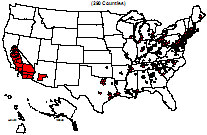 |
After Clear Skies and New Diesel Rules: 20202020: 263 of the 290 counties meet the new standard. Only 27 counties will need to take further steps to meet the standard. |
 |
Particulate Matter Air Quality Standards: 20022002: Approx. 129 counties do not meet New Particulate Matter Air Quality Standard. |
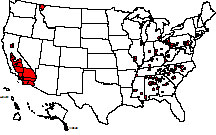 |
After Clear Skies and New Diesel Rules: 20202020: 111 of those 129 counties meet new particulate air quality standard. Only 18 counties will need to take further steps to meet standard. |
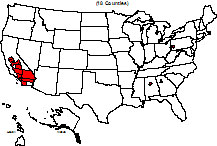 |
[TOP]
Clean Air Interstate Rule
In some parts of the country, sulfur dioxide (SO2) and nitrogen oxides (NOx) are transported by wind, causing environmental and health problems hundreds of miles away from the source. SO2 and NOx emissions contribute to the formation of fine particles, which can pose serious health risks, especially for people with heart or lung disease (including asthma) and older adults.
To address these concerns, as Congress continues to consider the Clear Skies legislation, the Bush Administration finalized a rule requiring power plants to make the steepest emissions cuts in more than a decade. The Clean Air Interstate Rule will require power plants in the 28 Easternmost states and the District of Columbia to upgrade their facilities to reduce SO2 and NOx. Through the use of the proven cap-and-trade approach, CAIR achieves substantial reductions of SO2 and NOx emissions and is a powerful component of the Administration's plan to help over 450 counties in the eastern U.S. meet EPA.s protective air quality standards for ozone or fine particles. The results will be better public health, ecosystems, and visibility:
- In 2010, CAIR will reduce SO2 emissions by 4.3 million tons -- 45% lower than 2003 levels, across states covered by the rule. By 2015, CAIR will reduce SO2 emissions by 5.4 million tons, or 57%, from 2003 levels in these states. At full implementation, CAIR will reduce power plant SO2 emissions in affected states to just 2.5 million tons, 73% below 2003 emissions levels.
- CAIR also will achieve significant NOx reductions across states covered by the rule. In 2009, CAIR will reduce NOx emissions by 1.7 million tons or 53% from 2003 levels. In 2015, CAIR will reduce power plant NOx emissions by 2 million tons, achieving a regional emissions level of 1.3 million tons, a 61% reduction from 2003 levels.
- In 1990, national SO2 emissions from power plants were 15.7 million tons compared to 3.5 million tons that will be achieved with CAIR. In 1990, national NOx emissions from power plants were 6.7 million tons, compared to 2.2 million tons that will be achieved with CAIR.
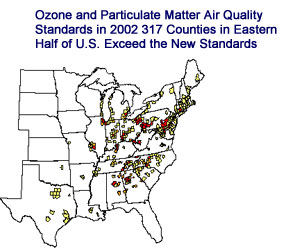
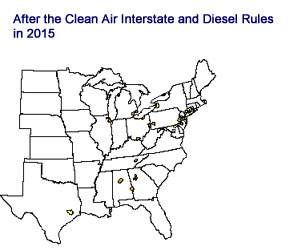
[TOP]
Clean Air Nonroad Diesel Rule
In May 2004, the Bush Administration finalized a rule that will dramatically reduce pollution from heavy-duty diesel engines used in construction, agricultural, and industrial equipment. This will prevent up to 12,000 premature deaths, 8,900 hospitalizations, 15,000 heart attacks, 6,000 children's asthma-related emergency room visits, 280,000 respiratory problems in children, and a million work days lost due to illness once the rule is fully implemented. Soot and NOx emissions will decrease by more than 90 percent by 2014, and the sulfur content of diesel fuel will be cut 99 percent by 2010.
[TOP]
Clean Air Mercury Rule
Mercury is a toxic, persistent pollutant that accumulates in the food chain. Mercury in the air is a global problem. While fossil fuel-fired power plants are the largest remaining source of human-generated mercury emissions in the United States, they contribute only a small amount (about 1 percent) of total annual mercury emissions worldwide.
On March 15, 2005, EPA issued the first-ever federal rule to permanently cap and reduce mercury emissions from coal-fired power plants. This rule makes the United States the first country in the world to regulate mercury emissions from coal-fired power plants.
The Clean Air Mercury Rule will build on EPA's Clean Air Interstate Rule (CAIR) to significantly reduce emissions from coal-fired power plants -- the largest remaining sources of mercury emissions in the country. When fully implemented, these rules will reduce utility emissions of mercury from 48 tons a year to 15 tons, a reduction of nearly 70 percent.
The Clean Air Mercury Rule establishes "standards of performance" limiting mercury emissions from new and existing coal-fired power plants and creates a market-based cap-and-trade program that will reduce nationwide utility emissions of mercury in two distinct phases. The first phase cap is 38 tons and emissions will be reduced by taking advantage of "co-benefit" reductions - that is, mercury reductions achieved by reducing sulfur dioxide (SO2) and nitrogen oxides (NOx) emissions under CAIR. In the second phase, due in 2018, coal-fired power plants will be subject to a second cap, which will reduce emissions to 15 tons upon full implementation. New coal-fired power plants ("new" means construction starting on or after Jan. 30, 2004) will have to meet stringent new source performance standards in addition to being subject to the caps.
Myths and Facts of Mercury Regulation
Myth #1: The EPA does not regard mercury as a toxin.
- Fact: EPA recognizes mercury as a toxin and that it needs to be reduced under the Clean Air Act.
Myth #2: EPA is rolling back the standard.
- Fact: Currently, there is no standard. The Bush Administration is setting the standard for the first time in the United States.
Myth #3: Technology exists to reduce mercury by 90 percent by 2007.
- Fact: EPA scientists do not believe that new technologies will be widely distributable to control mercury emissions from all coal and boiler types until after 2010.
Myth #4: EPA is delaying the benefits of mercury regulation until 2018.
- Fact: The substantial amount of emissions reductions, using a cap and trade system, will be in the early stages. There are incentives for early reductions with the credit banking program.
[TOP]
Cleaner Fuels and Engines
Cleaner Fuels and Engines "First, we're going after the pollution that comes from diesel vehicles. We worked with the energy companies and the agricultural concerns and the manufacturers; we worked with environment groups; we worked with union groups-to come up with a common-sense policy. And we did, we developed one. It's now being implemented. Oil companies will lower the sulfur in diesel fuel. We'll enforce new emission limits on diesel truck engines. And we're going to put forward new rules that will control pollution from off-road vehicles like heavy construction equipment."
President George W. Bush
Remarks by the President to Plant Employees and Local Community Leaders
Monroe, Michigan, September 15, 2003
The Bush Administration consistently advocates tougher controls on harmful air pollution caused by gasoline and diesel engines.
Tier 2 Vehicle and Gasoline Sulfur Program: Starting this model year, and phasing in over the next three years, tougher new pollution standards on gasoline and diesel vehicles go into effect as part of the Tier 2 Vehicle and Gasoline Sulfur program, cutting pollution from these sources by 77 percent to 95 percent depending on the size of the vehicle. The program will result in annual emissions reductions of 2.2 million tons of NOx and 306 thousand tons of VOCs by 2020, and will also result in cleaner-burning gasoline that contains 90 percent less sulfur.
Diesel Retrofit: A voluntary partnership program with industry and State and local authorities will reduce emissions by retrofitting diesel engines. Commitments already made to retrofit over 130,000 diesel engines in trucks, buses, locomotives, and construction equipment will eliminate more than 200,000 tons of harmful pollution from the air.
Cleaner Off-Road Vehicles: In September 2002, EPA established emissions standards for hydrocarbons, carbon monoxide, nitrogen oxides, and particulates for several categories of off-road engines. Emissions will be cut 50 to 90 percent from current levels for certain vehicles, a reduction of approximately four million tons of pollution each year.
[TOP]
Clean School Bus USA Program
 The President's FY 2005 budget request
expands the Clean School Bus USA program from $6.5 million in
FY 2004 funding to $65 million. The expanded program will provide grants to governmental entities to replace pre-1991 school buses with new clean school buses offering state-of-the-art emission control and safety features and to retrofit post-1990 school buses with similar advanced emission controls.
The President's FY 2005 budget request
expands the Clean School Bus USA program from $6.5 million in
FY 2004 funding to $65 million. The expanded program will provide grants to governmental entities to replace pre-1991 school buses with new clean school buses offering state-of-the-art emission control and safety features and to retrofit post-1990 school buses with similar advanced emission controls.
[TOP]
Cleaner Air Partnerships
EPA has adopted the Administration's focus on partnerships and is implementing a wide range of voluntary agreements with communities, industries, and state and local governments to reduce air pollution.- Commuters' Choice Program - This is a joint Department of Transportation and EPA effort to
encourage
public transportation use and reduce traffic and air pollution. Hundreds of employers volunteered to operate these programs, providing benefits to hundreds of thousands of commuters.
 SmartWay Transport - This voluntary
partnership with truck and rail transport companies aims, by 2012, to reduce up to 200,000 tons of NOx annually.
SmartWay Transport - This voluntary
partnership with truck and rail transport companies aims, by 2012, to reduce up to 200,000 tons of NOx annually.
- Anti-Idling Strategies - To save fuel and reduce air emissions, the Bush Administration is
working with
the trucking industry to improve idle control technologies and reduce idling at truck stops and travel centers.
- Congestion Mitigation and Air Quality Improvement - These public-private partnerships and
experimental
pilot projects showcase new technologies and new ways of working with state, local, and non-governmental organizations. Recent projects include: Port of Houston's use of water-emulsion fuel powering equipment; a new demonstration truck stop electrification project in New York; and the use of compressed natural gas in automobiles in Atlanta.
- Combined Heat and Power Partnership (CHP) - This partnership program promotes the market for combined heat and power (or co-generation), a highly efficient method of using heat created during conventional power generation. This increases power generation without additional pollution. The program includes 90 partners, and through 20 projects, has created almost 700 megawatts of new CHP capacity, roughly enough for more than a million people in one day
[TOP]
Improving New Source Review
While the New Source Review (NSR) program helps keep emissions low at new facilities, it has also been an obstacle to achieving improved efficiency at existing facilities, and to operating these plants more safely and reliably. In a 2002 letter to then-EPA Administrator Christine Todd Whitman, a bipartisan group of 26 senators wrote, "The NSR program needs to be clarified to adequately define the concept of 'routine maintenance' to avoid the regulatory uncertainty currently facing industry. Such clarification would allow companies to repair their facilities and maintain reliable and safe electric service for consumers and workers without being subject to the threat of Federal Government lawsuits for allegedly violating vague NSR requirements." The Nation's governors unanimously agreed on the need for reform at their annual summer meeting in 2001, and the Nation's environmental commissioners similarly agreed at the annual meeting of the Environmental Council of the States.
In 2002, EPA reviewed the NSR program and reported to the President with recommendations for its improvement. Several of these recommendations became final EPA rules in December 2002. The rules provide facilities with increased flexibility to improve and modernize their operations by taking steps that will reduce energy use and air pollution. The rules provide incentives to install state-of-the-art pollution controls and more accurately calculate actual emissions of air pollution. These improvements will remove confusing and unintended regulatory barriers to investments in energy efficiency and pollution control projects, while preserving the intended environmental benefits of the NSR program.
EPA also issued a rule in August 2003 to clarify the definition of "routine maintenance" - a key part of NSR. This clarification will remove the disincentives for owners and operators of power plants and manufacturing facilities to undertake routine maintenance, repair, and replacement activities that would improve safety, reliability, and efficiency of their plants. These reforms reflect longstanding, broad bipartisan consensus that the program needs to be improved. EPA's improvements will preserve NSR's intent and effectiveness, and not allow power plants to increase emissions past other Clean Air Act permitted limits, while removing unintended obstacles to investments in newer, cleaner, safer, and more efficient production processes. EPA will move forward with this rule following further review and successful resolution of pending litigation.
[TOP]
Improving Visibility in America's National Parks
On April 16, 2004, the Bush Administration proposed a rule amending EPA's 1999 Regional Haze Rule that will help improve visibility in our parks by requiring the installation of best available retrofit technology (BART) on older facilities emitting pollution that states determine harms visibility in specially protected areas. States will be required to identify facilities subject to BART controls and determine the level of pollution control technology required. Under this rule, EPA estimates that BART would result in emission reductions of approximately 2.2 million tons of sulfur dioxide and 1.2 million tons of nitrogen oxides by 2015, with additional reductions from other types of facilities. Many of these facilities previously have not been subject to Federal pollution control requirements for visibility-harming pollutants. For some of the source categories, existing technology can reduce emissions by 90 to 95 percent. Combined with the President's other clean air rules, the BART proposal offers an additional tool for states to address remaining sources of air pollution in the United States.
[TOP]










